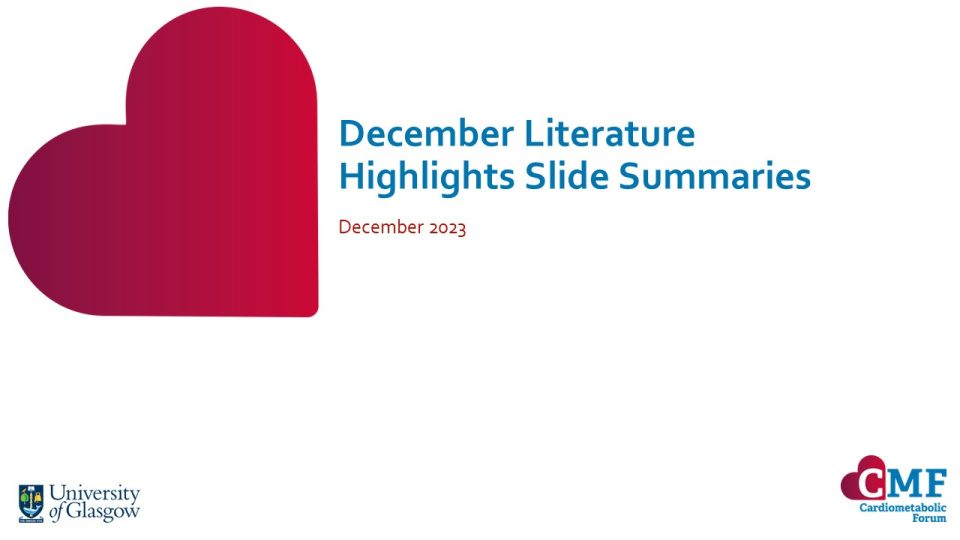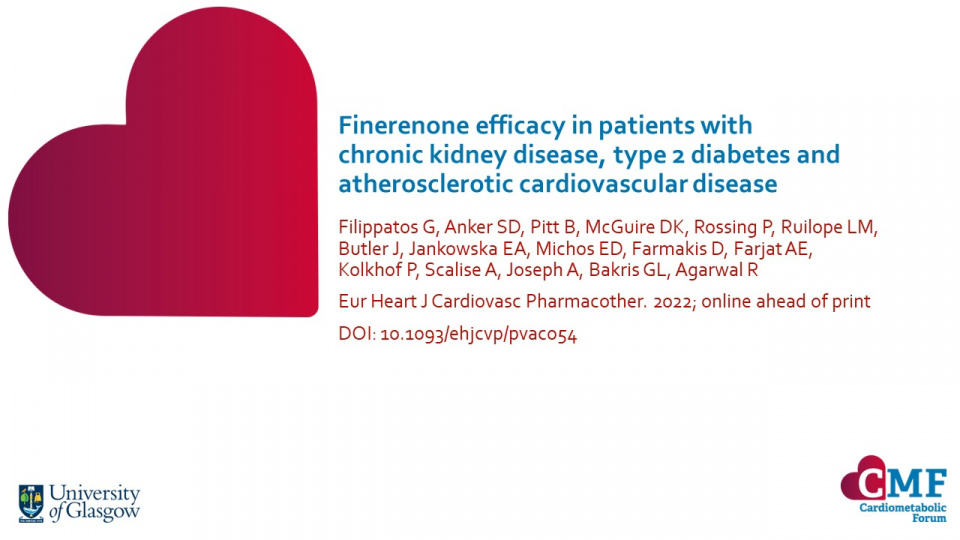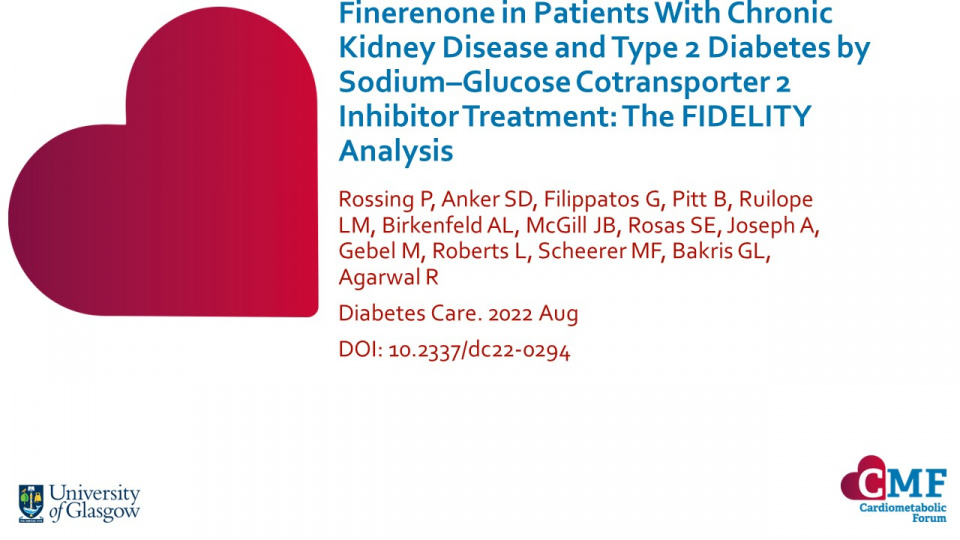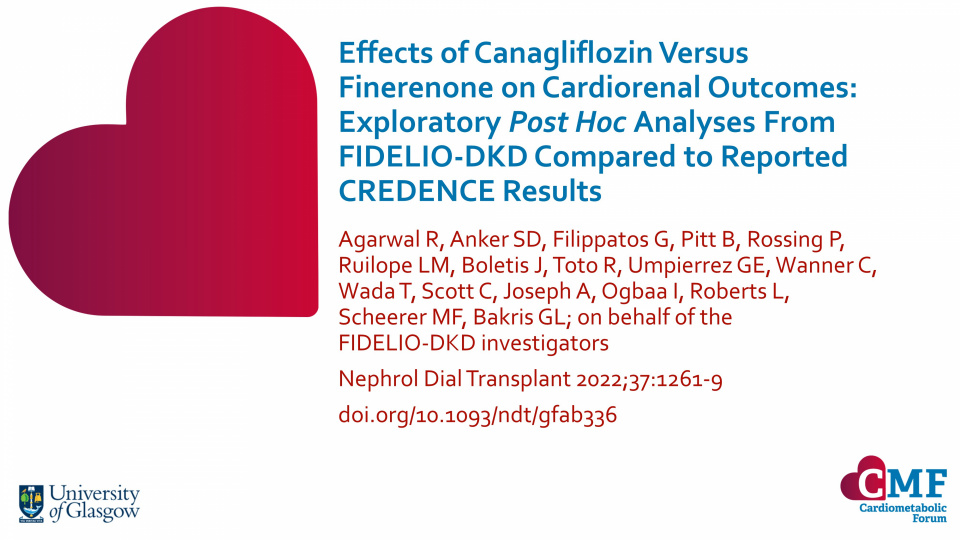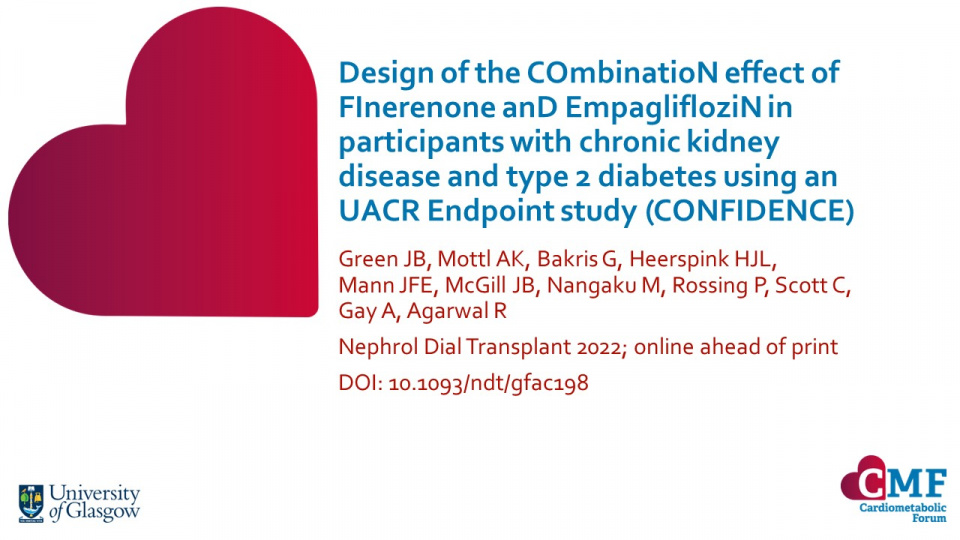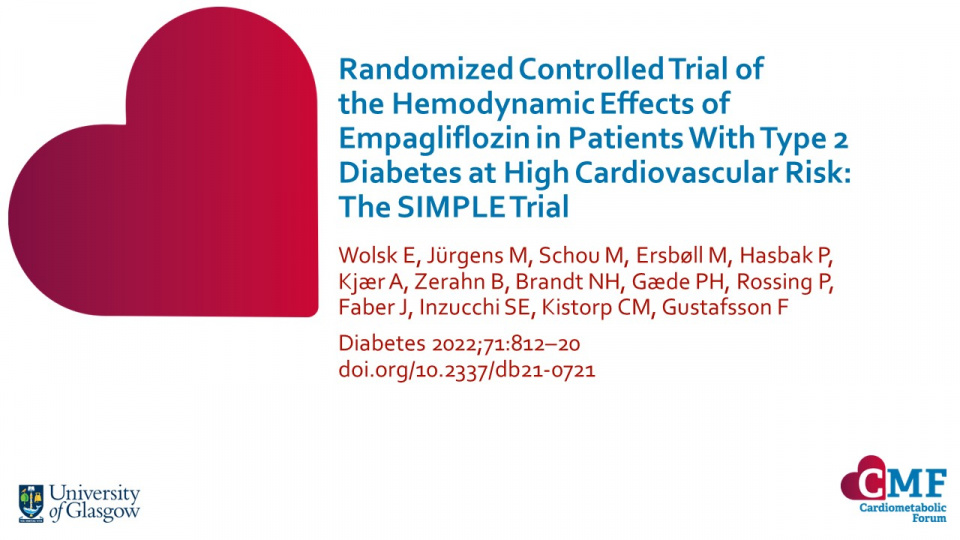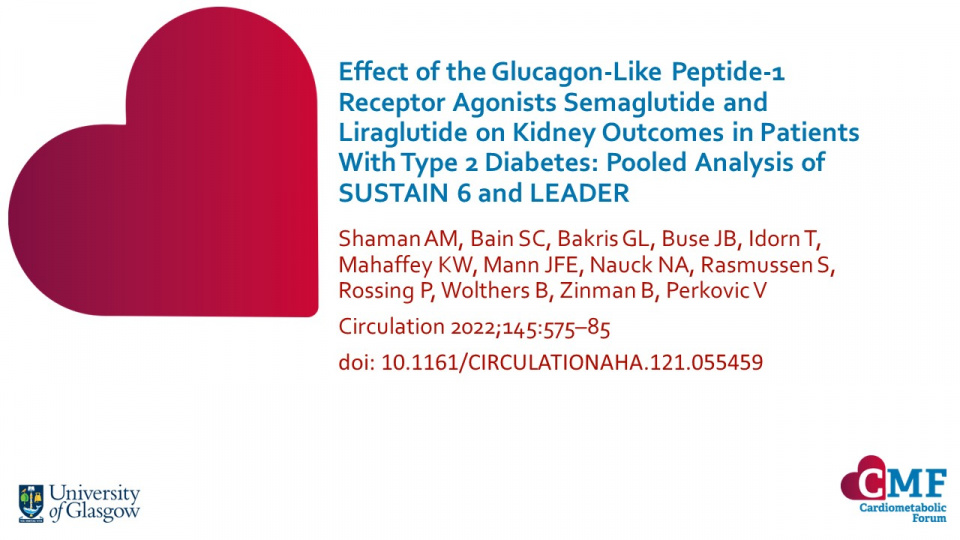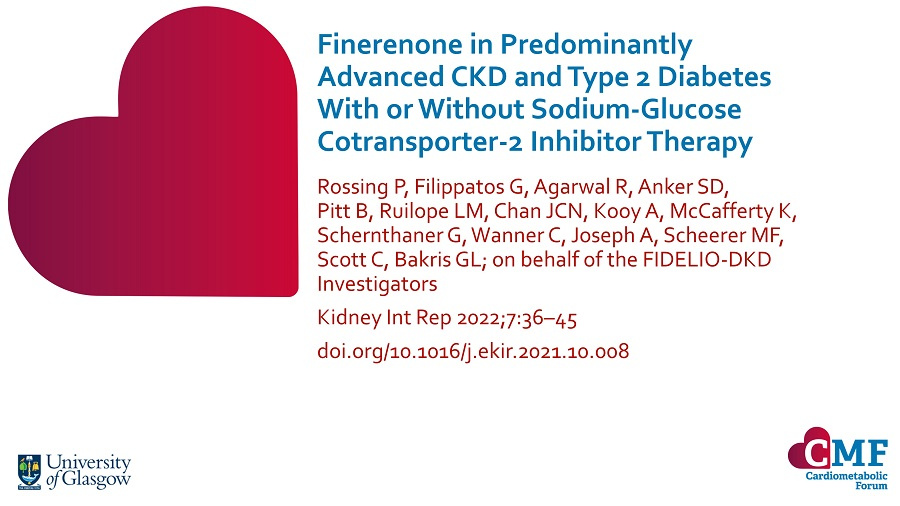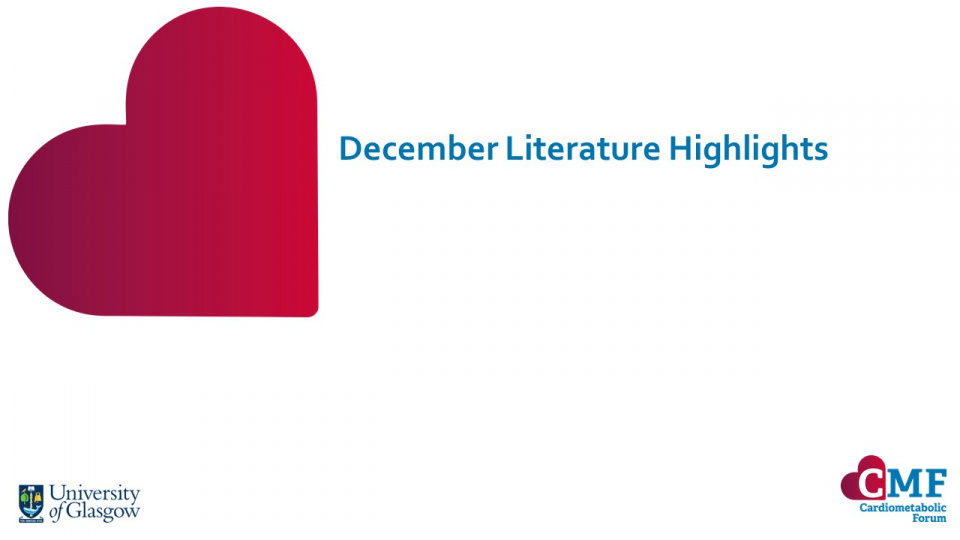Publications
Stay up to date with our literature reviews which are curated by experts to feature the most important publications released each month. Explore our publications for access to concise summary slides for your own use.
Finerenone efficacy in patients with chronic kidney disease, type 2 diabetes and atherosclerotic cardiovascular disease
Eur Heart J Cardiovasc Pharmacother. 2022; online ahead of print DOI: 10.1093/ehjcvp/pvac054
Finerenone reduced the risk of CV and kidney outcomes consistently across the spectrum of CKD in patients with T2D, irrespective of prevalent ASCVD.
Finerenone in Patients With Chronic Kidney Disease and Type 2 Diabetes by Sodium–Glucose Cotransporter 2 Inhibitor Treatment: The FIDELITY Analysis
Diabetes Care 2022; online ahead of print doi: 10.2337/dc22-0294
In the FIDELITY analysis, finerenone reduced the risk of cardiovascular and kidney outcomes compared with placebo. Concomitant treatment with a sodium-glucose cotransporter-2 inhibitor (SGLT2i) did not modify the observed benefits.
FIDELITY pooled populations from the FIDELIO-DKD and FIGARO-DKD studies in order to examine the effect of finerenone and interaction with SGLT2i use on prespecified outcomes in patients with chronic kidney disease (CKD) and type 2 diabetes (T2D). In both trial, use of SGLT2i was permitted at baseline, as was initiation of SGLT2i at any time during the trial.
Effects of Canagliflozin Versus Finerenone on Cardiorenal Outcomes: Exploratory Post Hoc Analyses From FIDELIO-DKD Compared to Reported CREDENCE Results
Nephrol Dial Transplant 2022;37:1261-9 doi.org/10.1093/ndt/gfab336
This analysis highlights the pitfalls of direct comparisons between trials, since when key differences in design are considered, FIDELIO-DKD and CREDENCE demonstrate similar cardiorenal benefits. The authors conclude that both canagliflozin and finerenone are similarly effective in reducing the risk of cardiorenal outcomes.
Design of the COmbinatioN effect of FInerenone anD EmpaglifloziN in participants with chronic kidney disease and type 2 diabetes using an UACR Endpoint study (CONFIDENCE)
Nephrol Dial Transplant 2022 Jun 14;gfac198. Online ahead of print. doi: 10.1093/ndt/gfac198.
CONFIDENCE is a new trial currently recruiting. The aim is to demonstrate that 6 months’ dual therapy with finerenone and empagliflozin is superior for reducing albuminuria versus either agent alone.
Despite available interventions, people with T2D remain at risk of chronic kidney disease, which puts them at further risk of kidney failure, CV morbidity, and all-cause mortality. There is therefore a need to slow or attenuate the progression of chronic kidney disease (CKD) and reduce CV morbidity and mortality in this population.
Finerenone and sodium-glucose cotransporter-2 inhibitors (SGLT2i) can both reduce kidney and CV risks, acting via both shared and distinct pathophysiological pathways. Results from post hoc subgroup analyses and a preclinical model suggest dual therapy may provide additive renoprotective effects than using either class alone.
Randomized Controlled Trial of the Hemodynamic Effects of Empagliflozin in Patients With Type 2 Diabetes at High Cardiovascular Risk: The SIMPLE Trial
Diabetes 2022;71:812–20 doi.org/10.2337/db21-0721
In this analysis of data from the SIMPLE trial, empagliflozin did not reduce left heart filling pressure more than placebo at submaximal exercise in patients with T2D at high CV risk. However, it was observed that empagliflozin reduced pulmonary capillary wedge pressure (PCWP) at a magnitude of clinical significance in patients at rest. The findings suggest cardiac benefits beyond the diuretic effect of sodium-glucose co-transporter-2 inhibitor (SGLT2i) treatment and could explain a significant part of the CV benefits observed in clinical trials.
Effect of the Glucagon-Like Peptide-1 Receptor Agonists Semaglutide and Liraglutide on Kidney Outcomes in Patients With Type 2 Diabetes: Pooled Analysis of SUSTAIN 6 and LEADER
Circulation 2022;145:575–85 doi: 10.1161/CIRCULATIONAHA.121.055459
In this analysis by Shaman et al., semaglutide and liraglutide offered kidney-protective effects in patients with type 2 diabetes, especially those with pre-existing chronic kidney disease.
Finerenone in Predominantly Advanced CKD and Type 2 Diabetes With or Without Sodium-Glucose Cotransporter-2 Inhibitor Therapy
Kidney Int Rep 2022;7:36–45 doi.org/10.1016/j.ekir.2021.10.008
Finerenone was associated with a 31% greater reduction in urine albumin:creatinine ratio (UACR) from baseline to Month 4 versus placebo. With similar reductions in UACR seen whether the patient was receiving SGLT2i at baseline or not.
December Literature Highlights
Multiple sources (see slide deck for information)
Single slide summaries of all this month's selected publications.
Effects of Canagliflozin Versus Finerenone on Cardiorenal Outcomes: Exploratory Post-Hoc Analyses From FIDELIO-DKD Compared to Reported CREDENCE Results
Nephrol Dial Transplant 2021;gfab336 doi: 10.1093/ndt/gfab366
Finerenone and canagliflozin reduce cardiorenal risk in patients who are albuminuric. This exploratory post-hoc analyses by Agarwal et al. investigated how differences in trial design influenced observed treatment effects in the FIDELIO-DKD and CREDENCE studies.
Dapagliflozin and New-Onset Type 2 Diabetes in Patients With Chronic Kidney Disease Or Heart Failure: Pooled Analysis of the DAPA-CKD and DAPA-HF Trials
Lancet Diabetes Endocrinol 2022;10:24–34 doi.org/10.1016/
Chronic kidney disease and heart failure are insulin resistant states associated with high incidence rates of diabetes. Rossing et al. carried out a two Phase 3, randomised, double-blind, placebo-controlled trials assessed the effect of dapagliflozin on new-onset type 2 diabetes, in a pooled analysis of data from 6,608 individuals.

